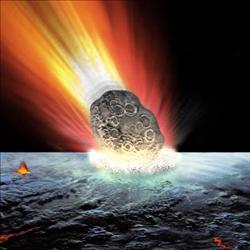Despite the holidays, a herculean effort went into acquiring additional observations of asteroid 2004 MN4 and in searching for the object in old images. A couple of days ago, Jeff Larsen and Anne Descour of Spacewatch Observatory managed to locate the asteroid on images taken March 15 of this year, greatly extending the time span of the observations. Measurements of 2004 MN4’s positions on these images, combined with additional observations, enabled members of the Spaceguard Survey to reduce the uncertainty in the orbit and rule out an impact in 2029. Furthermore, it looks like this asteroid will not pose a significant threat for the next 100 years.
It’s still going to pass close — current estimates put it missing us by about 40,000 miles. At this distance, observers located in the right place — say near London, England — around 10 P.M. on Friday, April 13, 2029, should be able to see the asteroid with the unaided eye. It’ll be a dim 5th magnitude star near the constellation Gemini moving about 2.5° per minute — about half as fast as the International Space Station appears to move across the sky. At this speed, the asteroid will be very hard to track with a telescope.
For researchers involved with the Spaceguard Survey, the international effort to locate asteroids that may pose a hazard to Earth, 2004 has been an interesting year. It began and ended with an apparent asteroid threat.
On January 14, initial observations of an asteroid named AL00667 seemed to indicate it had about a 25 percent chance of hitting Earth within 36 hours. The situation prompted asteroid hunters to discuss who should be warned of the impending impact. Further observations — made by an amateur that same evening — ruled out a hit. Although AL00667 missed us by over a million miles, the incident forced astronomers to think about the practical consequences of an unlikely event.
Now, we have 2004 MN4, an asteroid that, as of this writing, astronomers give a 2.7 percent chance of striking Earth — odds of 1 in 37 — on Friday, April 13, 2029. The asteroid was discovered June 19, 2004, by Roy Tucker, David Tholen, and Fabrizio Bernardi from Kitt Peak, Arizona, but it was observed for only 2 nights. On December 18, Gordon Garradd of Australia’s Siding Spring Survey rediscovered the object. Further observations from around the globe over the next several days confirmed its connection to the June discovery. At this point, automatic systems recognized the impact possibility and provided predictions.
In the case of AL00667, observations almost immediately reduced the chance of impact to zero. But additional observations of 2004 MN4 (169 of them from June to the present) actually have increased its chances of collision from 1 in 300 (December 23rd) to 1 in 60 (December 24th) to the current 1 in 37. The impact probability has gone up, rather than down.
MN4 is the first object to break a rating 2 on the Torino impact hazard scale, a classification, similar to the Ritcher scale for earthquakes, designed to quantify the impact risk of near-Earth asteroids. The asteroid is currently standing at 4, which signifies an “event meriting concern” and is defined as “a close encounter with 1 percent or greater chance of causing regional devastation.”
The current guess of 2004 MN4’s size is about 1,300 feet (400 meters) across, which is too big to be broken up by the atmosphere. If it were to hit, astronomers estimate its striking power at 1,400 megatons, nearly 28 times greater than the largest nuclear weapon ever detonated. This asteroid would leave a hole big enough to swallow a small city — and this ignores the effects of the blast wave, which would damage a much larger area. (For a closer look at the potential effects of MN4’s impact, see the University of Arizona Lunar and Planetary Lab’s interactive web page, Effects of an impact on Earth.)
If the rock is as small as 300 feet (100m) in diameter, the atmosphere will probably break it apart before it hits the ground. The estimated size depends on how much light the surface of the asteroid reflects, and astronomers do not have a good idea of its composition at this time.
But before we get on the phone to Bruce Willis and tell him to break out the mining gear, bear in mind that the impact probability likely will decrease as more observations become available — especially radar observations. Because it permits precise determinations of speed and distance, radar is used for refining asteroid orbits. NASA’s Near Earth Object Program impact risk web page will reflect changes to our understanding of 2004 MN4’s orbit, but things may not change very much until an opportunity for radar observation occurs.
If the chance of collision continues to climb, we’ll have more than 24 years to prepare for a possible impact, and there are many folks already working on the problem of deflecting an asteroid.
It’s likely the chances of a collision with 2004 MN4 will soon be reduced to zero, but until then, members of the Spaceguard Survey are closely watching this asteroid.
Sooner or later, the improbable does happen. Just ask the dinosaurs.










